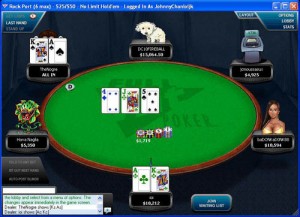This website uses cookies so that we can provide you with the best user experience possible. Cookie information is stored in your browser and performs functions such as recognising you when you return to our website and helping our team to understand which sections of the website you find most interesting and useful.
HU Short Stack Strategy
Heads Up Tournament Strategy – A Guide to Short Stack Play
Looking to improve your heads up tournament play? We’ve got useful tips for upping your win rate in HU situations. The following article focuses on heads-up situations with shallow stacks, a particularly difficult situation for newer players.
 Be Prepared To Gamble- When playing heads up in a tournament, most of the time, your stacks should have room for some play; stacks of 50+ BB’s are usually the norm when you get to the heads up stage of bigger tournaments. But, sometimes, you may be in a turbo, or the grind of the tournament took its toll on the relative stacks, and suddenly, you’re faced with the prospect of playing short stacked for the title. What does this mean for you? The first, and most important thing to grasp onto is this; you’ll have to gamble at some point in the affair to win. With 30 or less big blinds in each of your stacks, the upcoming blind increases will decimate both of your stacks to the point of making the tournament a bit of a crapshoot. So, while you have the time to gamble up for a stack, especially if your opponent is passive, you should be pouncing on these opportunities.
Be Prepared To Gamble- When playing heads up in a tournament, most of the time, your stacks should have room for some play; stacks of 50+ BB’s are usually the norm when you get to the heads up stage of bigger tournaments. But, sometimes, you may be in a turbo, or the grind of the tournament took its toll on the relative stacks, and suddenly, you’re faced with the prospect of playing short stacked for the title. What does this mean for you? The first, and most important thing to grasp onto is this; you’ll have to gamble at some point in the affair to win. With 30 or less big blinds in each of your stacks, the upcoming blind increases will decimate both of your stacks to the point of making the tournament a bit of a crapshoot. So, while you have the time to gamble up for a stack, especially if your opponent is passive, you should be pouncing on these opportunities.
Understanding How To Gamble: Tight Players- Now, the points in which you can gamble are trickier than they may appear. If you’re against a passive, weak player that has tightened up since getting close to the big prize, amp your aggression up to the max; open every button, pop most of his limps up, just relentlessly pour pressure on him at every angle, in an attempt to bleed him down to a stack that you gamble with if he does wake up with a hand. If you’ve spent the past 10 hands grinding his 30 blind stack down to 15, and he then wake up with QQ when you open shove K4d into him, you still have a chance to put the tournament away with your overcard, and if you don’t? You’re back to where you started, with 30 blinds each. It’s the SuperSystem theory of constant aggression at work.
Understanding How To Gamble: Loose Players- It’s a bit harder to pick up on when gambling is right if your heads up opponent turns out to be a maniac, as well. If the stacks are shallow, the best advice you can take from me is this; be a lot more willing to gamble with the lower range of your “good” hands than you normally would. For example, your maniac opponent, apparently just playing with free poker money has open shoved his 25 blind stack the past 6 times he’s been the button. He makes the same play again, and you have A8s in your big blind. This is an auto-call against this particular opponent; he’s been shoving any button with reckless impunity, and you haven’t stood up to him yet, so he’s surely widening his range to the point that he may ship any two cards here. Your suited ace stands to be a good favorite over his shoving range, so get it in there and call. This is where hands like 44, K10, and QJs become calling hands against a maniac; it may seem a little unnatural to put your tournament on the line with K10 or QJ, but when your opponent is opening any two cards, you’ll be suprised how many times your motley hand is actually a monster favorite over his Q5s or J8o.






